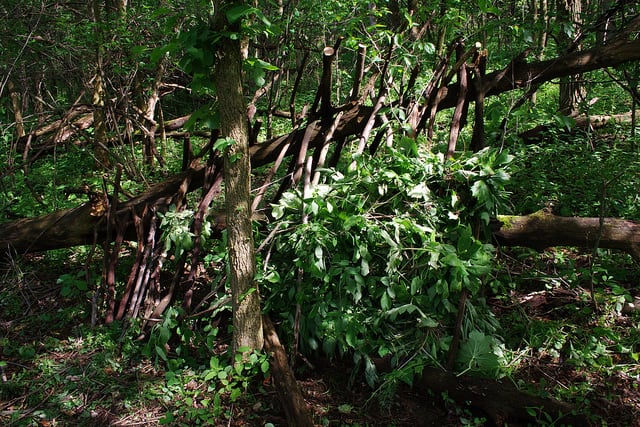If you want to know how to survive in the wild, then the first thing you need to know is this: always be prepared. You don’t want to be caught without supplies.
Never go for even a “short walk” in the woods without bringing a fire starter, knife, water, and rain jacket.
Even if you don’t plan on going into the wilderness, you still need to be prepared with survival gear. Keep a car emergency kit in your vehicle in case you break down on a remote road. Keep a bug out bag packed in case you need to flee.
But you can’t always be prepared for everything.
You could go for a hike, fall into a river, and have all of your gear wash away. Or you might get abducted by a nutcase and have to escape your abductor through the woods (yes, this has happened many times).
The bottom line is that you need to be prepared for anything by knowing how to survive in the wilderness.
You Only Need 4 Things to Survive in the Wild
Unless you are injured or sick, there are just 4 things that you need in order to survive in the wild. Yes, only 4!
- Water
- Shelter
- Food
- Warmth
Hopefully you will have survival supplies to help you get these 4 things – like having emergency food and water rations, a tent for shelter, and matches so you can make a fire to stay warm.
But, if not, don’t despair. You’ve got a lot more resources around you than you realize! If you are ever lost in the wild with nothing, just follow these steps.
1. Find Water
The first thing you need to survive in the wild is water. You can only go 3 days without water before dying, but you’ll be extremely dehydrated long before those 3 days are up. Hopefully you can find a stream or creek to drink out of. If you can’t find a ready supply of water, then you can use these tactics to get water:
- Collect Dew: Take your shirt off and press it onto the ground to collect dew. You can then wring the dew into your mouth or into your water bottle.
- Drag a Piece of Cloth Behind You: There is a lot of water in the woods on plants. Drag a piece of cloth behind you (or wrap it around your legs and walk through thick brush). The cloth will collect the moisture and you can wring it out into your mouth.
- Follow Ants: If you see a train of ants going up a tree, it is probably because there is a cache of water in a groove in the tree.
- Travel Parallel to a Mountainside: If on a mountain, cross it by staying parallel. Mountains usually have streams going down them so you are likely to come across one eventually.
- Dig for Water: If you dig, do so at places like dried-up streams and areas with a lot of lush foliage.
Read this post to learn more ways to find water in the wilderness.
And remember that water from lakes, streams, and rivers should always be purified before you drink it, even if it looks clean! Read this post to learn how to purify water in survival situations.
2. Make a Shelter
You will need a shelter to protect you from the elements. A shelter can also help protect you from some wild animals as they are more likely to attack you if you are in the open. Making a survival shelter in the woods is actually fairly easy. Remember to have your shelter made before it gets dark!
My favorite shelter for how to survive in the woods is the “fallen debris shelter.” You just need to find a fallen tree. Then pile some large branches against it to act as a shelter wall. Then you fill in the gaps with smaller branches.
There are many other ways to make shelters in the wilderness though. Read this post to see some survival shelter designs.
3. Stay Warm
Temperatures can drop really quickly in the woods, so you better prioritize warmth. Staying warm is actually just as important as food for survival. And, if you are cold, then your body is going to require more food.
A well-built survival shelter will help you stay warm by trapping in your body heat. But you can do other things to improve your warmth.
One of my favorite stories about how to survive in the woods is that of Susan O’Brien. She survived a night in the woods by burying herself in dirt to stay warm. Dirt is a great insulator for when you don’t have an emergency blanket. You could also use fallen leaves, pine needles, or other debris.
Another way to stay warm is to make a fire. But, if you are lost in the woods without matches or a lighter, then this is going to be problematic.
Unless you are some sort of wilderness MacGyver, don’t even bother trying to rub two sticks together. You’ll just end up with 2 warm sticks.
Save your energy and snuggle up in your debris bed instead. Or, if you absolutely must make fire, then try these methods of making fire without matches.
4. Find Food
There is actually lots of food in the wild – so long as you know where and how to look for it. In survival situations, these would be your primary options for food:
- Wild animals
- Wild plants
- Insects and bugs
Sorry to break it to you, but catching a wild animal for food is a lot harder than it seems. Even if you have gear, it is really difficult!
The one exception to this is if you are stranded near some sort of lake. Then you should try one of these methods for fishing in the wilderness.
The better option for wilderness survival food is to eat bugs. Yes, I know this probably seems gross to you, but most bugs are edible and actually very nutritious.
As for eating wild plants, never eat a plant unless you are 100% sure it is edible. If you eat an inedible plant, you could end up with diarrhea, and that will kill you a lot faster than hunger!
In desperate situations, you can use the universal edibility test to tell if a plant is safe to eat.
Do you know how to survive in the wilderness? Let us know your tips and tricks!



Great article!
One suggestion, however, would be to consider reordering it. The Rule of Threes goes as follows:
You can survive…
3 hours without shelter
3 days without water
3 weeks without food
The idea behind the mnemonic is to help triage one’s effort in a survival situation.
You duly note that shelter is very important, and recommend it be finished by dark. But the initial hunt for water may leave one caught out for a night.
This has some really helpful information seeing as I am a camper and I love to be out in the woods. Thank you so much for this article and it helped me out quite a bit. – Sarah, Age 11
Thanks for all the info. I am camping outside shortly and thought it would be interesting to do some research about survival in the wild
when it comes to eating a worm or cambium bark, which one would eat?
I would choose cambium bark.
I was stranded over night once long ago in the winter. The temp was dropping below freezing and I didn’t have anywhere to get inside. Fortunately I’d seen a big hole full of dry leaves before it got dark, so I was able to bury myself in there ,pop my jacket hood up, and keep nice and warm. The bugs and I actually had quite a comfortable night, surprisingly!
BUGS
These are really good ways to survive. You should put that you can have a battery and gum wrapper to make a fire.
Nice
plz read /when you use two sticks you dont just get two warm sticks you can actually make a fire with two sticks ive done it many times so that fact is very un true there are many different methods such as a bow drill where you use a slightly bent stick and some cordege you made and a drill made from rounding the end of a stick on a rock then you need a flat sided stone and a piece of bark or some sort by using the bowdrill you made you use the rounded piece of wood you start to move the bow part by moving it back and fourth and the rounded piece and twist it around in your cordege and you put the rounded piece on the piece of bark or whatever flat piece of wood you found and start using it then once you start to see smoke dont get excited yet keep on moving the bowdrill once you start to see alot of smoke tip over you flat piece over into your tinder bundle and start blowing on your ember and eventullay youll have fire and be warm during night. ps i would prtice this alout to really get the hang of it so itll be easier
I am 13 yrs old
Hey Donald – thanks for dropping in! Keep learning and practicing and you will go far.
Why not save the calories and carry a ferro rod and some tender (natural or homemade). Tip: open up a cotton ball, liberally rub petroleum jelly inside it. That’s all there is to it. Once lit (with that ferro rod), this grease impregnated beauty will burn for up to 6 minutes almost every time. Plenty of time to get some progressively larger pieces of wood on the fire.
I would say it’s safe to estimate about 40% percent of people who know “about” survival won’t be ready when they need to survive.
Whether it be natural disaster or accidental. That is why bug out bags are a growing interest. 1 easily accessed in the house, and 1 in the trunk. I keep a medium sized tote in the trunk and 1 bag rdy.
On staying warm, I was stuck outdoors one night with no gear, when it went below freezing, and managed a good nights sleep by burying myself in a hole full of dry leaves! I curled up under half the leaves and pulled my coat hood up to cover as much of my face as possible, then put my face in the leaves as well. It was amazingly toasty and comfy, as I had dry leaves under me as well as over!
i am doing a school project on how to survive in the wild and these really helped me get most of my info thanks!
I loved these tips they helped me alot thx<3
This is great! My parents always worry when I am camping/traveling without them in case I might get into these situations. I’m going to be glad to tell them that I will be ready. -TK
This great info and simple but simple just gets us by man you have so much for us to use and learn thank you sir and thank you for sharing your knowledge.
Awesome stuff dude I’ll definitely use this when I go camping
I love survival and my mom says I can go camping outside one day. Your tips are awesome! I have a Survival guide and you have different stuff in your website. You are awesome!!! Faith Age11
Hey Faith. Happy to have you here and great to see the younger generation getting into this stuff!
Survival is my fav thing in the world.
Wow .
Same here. Age 12
Am 13 and I know how to survive by myself 😉